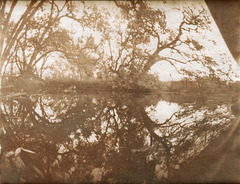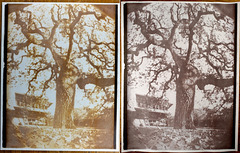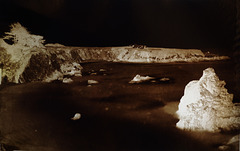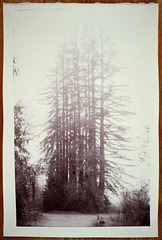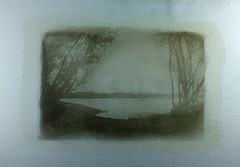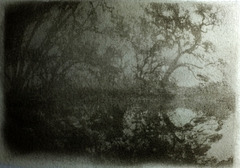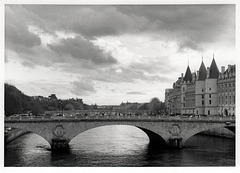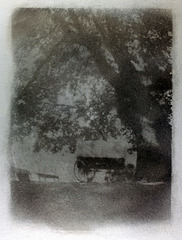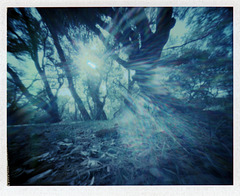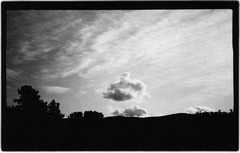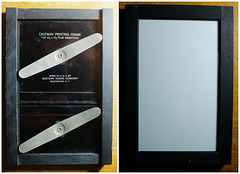Ned's photos
Ready for WPPD 2016
| |
|
|
|
I made this simple camera today to get ready for World Pinhole Photography Day on April 24th.
The camera uses a curved plane for 8x11, 7x11 or 6x11 inch photo paper, and has selectable rise ( or fall if you turn the camera upside down ). The camera is just a black foamcore box. The curve is formed by a mat board insert, and the paper snaps into place when loading; no need for tape or worry about paper slipping in a makeshift holder. On the right you can see the pinhole is mounted on a piece of mat board that can slide up or down. When it is all the way down it is centered for 8x11 paper. The pencil arrows mark the highest it can go without the corners of the paper vignetting. The pinhole was made in a piece of aluminum from a drink can, and is about 0.38mm. Hope to use this camera on WPPD.
WxHxD is 9 x 8 x 4.5 inches
Namias' Sepiaprint 2
| |
|
|
|
Another Namias' Sepiaprint, this time un-toned.
Pinhole paper negative from February 2015, Laguna de Santa Rosa.
Printed 4 March 2016
Namias' Sepiaprint
| |
|
|
|
Rodolfo Namias' Sepiaprint
Pinhole paper negative, heritage oak at Finley Community Center in Santa Rosa, California
Left: still wet after fixing. According to Namias, the browns would get much darker if allowed to dry.
Right: final dry print after toning.
I read Namias' 1901 article describing an iron-silver process. It is somewhat like a so-called “Van Dyke Brown” print, but uses citric acid instead of tartaric acid. It is not one of the historic processes that has remained popular today. I can't find much record of its use, except in “sepia paper” used for copying technical drawings, similar to the way blueprints were used. Since I had all the needed supplies, I thought I'd try it.
I followed the directions in the article and made this print from a pinhole paper negative. Everything went just as Namias described, which in itself is a refreshing change from usual. Usually there are all sorts of things that can go wrong, but it made a nice print on the first try.
This must be the simplest and easiest printing process I've ever tried:
* brush on the senistizer, let dry
* expose the print
* wash for 2- 3 minutes
* fix for 2-3 minutes
optional: tone after fixing
* wash.
Everything was done as simply as possible. I already had eyedropper bottles of
24% silver nitrate
12% citiric acid
that I use to make salt prints. I made another eyedropper bottle with:
25% ammonium ferric citrate
A drop ratio of 1:2:2 is close to the formula in Namias' article. I used:
6 drops silver nitrate + 12 drops citric acid + 12 drops ammonium ferric citrate
This was much more than enough to coat a piece of 5x7 inch paper.
I used Canson Universal Sketch paper, which does have an alkaline buffer, but it worked just fine.
You can see the highlights are perfectly clear white with no fogging and no hint of yellow.
Brushed on with an inexpensive foam brush, no brush marks or uneven areas are visible.
Exposed it for ½ hour under BLB compact fluorescent lamps, it did not look done, so exposed for ½ hour more. Then it was time for dinner so I just turned the lamps off.
After dinner, it was interesting to see the image intensify in the wash, just as Namias described. Then it intensified again and changed color in the hypo. I used a rounded ½ teaspoon of sodium thiosulfate in about 60ml water to fix the image.
Namias recommended gold thiocyanate toner after fixing, so I mixed a weak toning solution of:
2.5 ml 0.2% gold chloride + 2.5ml 2% ammonium thiocyante in about 70ml distilled water.
Toned in this for about 10 minutes, until it did not seem to be changing much.
Washed for an hour then dried on a sheet of glass overnight.
I think it is remarkable how there is detail in the deepest shadows ( on the tree and in the background on the right ) and in the most extreme highlights ( bulletin boards on the building in the background ). Also the sky is perfectly paper white.
This is a fun and interesting process, and particularly simple. Next time I will let one dry down without toning and see what it looks like. With the right negative, it might make a nice print!
Duncan's Landing Salt
| |
|
|
|
Salt print from calotype.
Calotype had a few spots touched up on back w/ soft pencil.
Lana Aquarelle, 2% alaea salt, 0.5% CA, 0.8% gelatine.
Sensitized with 12% AgNO3, 6% CA.
Bright overcast at start, partly sunny after first 1/2 hour.
1h 25m toward N sky with paper diffusor.
10m facing E away from sun, no diffusor.
2m direct 4PM sun.
Toning:
2ml 0.2% gold chloride + 2ml 2% ammonium thiocyanate in about 80ml DH2O. 12 minutes.
Followed by:
0.2g borax + 1ml 0.2% gold chloride in about 80ml water, 10 minutes
Hard to get the tone right on this digi-snap. It is a little more neutral, but also a tiny bit more toward dark purple in the water. It also looks sharper with more "pop".
Printed 27 February 2016
Duncan's Landing
| |
|
|
|
Duncan's Landing on the Sonoma Coast in California. The rock point in the distance is locally known as "Death Rock" because large waves occasionally wash over it and many fishermen have been swept off. Now the cliffs are fenced off with warning signs, but fishermen still occasionally take the risk until the park ranger chases them off.
Greenlaw's process.
7x11 Eastman View No. 2, un-cataloged Wollensak lens.
LV 15, but it is hard to judge UV at the coast. I treated it as LV 16: F/45 12 minutes.
Developed in 1.4g gallic in 200 ml DH2O
No image visible at start.
Added 2 eyedroppers of aceto-nitrate of silver ( ~0.75ml each )
Image appeared more slowly than usual.
At 38 minutes, added another 1/2 eyedropper, which did speed things up but not too much and still under good control.
Done at 50 minutes.
Dried for 3 days under a heavy book between several changes of blotter paper.
I think the calotype was slightly underexposed, but it looks fine and I hope it will print well. If I like the way it comes out, it may start a series of seaside calotypes.
This is a poor reproduction. I had to put it into a printfile sleeve because it was curling. The trees on the clifftop are perfectly crisp and full of detail. But you can get an idea what it looks like.
After making this, I read Dr. Mansell's The calotype on the sea-shore with great interest. Perhaps I will try to follow his instructions while making my own "calotype on the sea-shore" series.
Redwoods in Fog
| |
|
|
|
Gold toned salt print made from a calotype.
Printed 7 February 2016
This "fairy ring" of redwood trees is probably on the same ground a prehistoric giant once stood upon. At Riverfront Regional Park near the Russian River in Sonoma County, California.
Isle of Redwoods
| |
|
|
|
This "fairy ring" of redwood trees is probably on the same ground a prehistoric giant once stood upon. At Riverfront Regional Park near the Russian River in Sonoma County, California.
Greenlaw's process.
7x11 Eastman No. 2, un-cataloged Wollensak lens.
My first successful calotype with this camera!
LV ~12, heavy fog. 25m @ f/16
Developed in 1.4g gallic acid in 200ml DH2O.
No visible image at start.
No image after 5 minutes in gallic.
Added 2 eyedroppers aceto-nitrate of silver, developed 45 more minutes, until shadow detail apparent and could not see shadow of fingers moving behind the sky.
Hope to make a print tomorrow.
Lake Benoist
| |
|
|
|
At Riverfront regional park Another non-toxic oil print made from a pinhole paper negative. I liked the last results better but the process worked well on this one. I'm still trying to figure out how to do this!
I'm not exactly sure when I made this photo... it was another from a box I've never scanned or printed before. Looks like it was made with my "red rooster" coffee can camera :)
Inked 20 January 2016
Laguna de Santa Rosa
| |
|
|
|
Still working on the non-toxic oil prints. This is an oilprint using AFC instead of bichromate. I'm having mixed luck, but having fun trying to make it work.
It was made from a pinhole paper negative. I've never printed or scanned this negative before, I think it is from February 2015 "red rooster" coffee can pinhole camera.
Printed / inked 17 January 2016
Around the World
| |
|
|
|
This negative is traveling around the world to be printed by different people. It came to me from Germany, next stop is Greece. I think it was in Paris too :).
Printed 9 January 2016.
oak and cart
| |
|
|
|
at Sutter's Fort in Sacramento, California. Pinhole paper negative from Oct. 2012.
This is an oil pigment print made using AFC instead of bichromate. I've been working at this process for a few weeks and this is the first partially "successful" one. It is inked like a bromoil print.
The process is non-toxic. There are still a few "kinks" to work out.
Spring Lake
| |
|
|
|
Met up with a nice fellow from APUG yesterday and tried out a new tripod for my camera at Spring Lake, near Santa Rosa, California.
This is a paper negative exposed for salt printing... I made a salt print from it today but it had an odd defect I've never seen before, so I'll try again another day. Meanwhile here's an inverted scan.
Ragle Ranch Oak
Ragle oak forest
| |
|
|
|
The sun moved during the ~15m exposure.
There was a photographer at the park photographing a couple and their baby, and for about 5 minutes they all were in this view. I can't see them, but I have an almost subliminal sense that I can tell they were there....
paper sky 3
| |
|
|
New contact print of an old paper negative.
Negative from Oct. 2012, printed Oct 2015.
I'm going to start making more of these again.
paper sky 2
| |
|
|
|
New contact print of an old paper negative.
Negative from Oct. 2012, printed Oct 2015.
I'm going to start making more of these again.
paper sky 1
| |
|
|
New contact print of an old paper negative.
Negative from Oct. 2012, printed Oct 2015.
I'm going to start making more of these again.
New Toy
| |
|
|
I was excited to find this original contact printing frame for Kodak postcard film and paper. It was made for printing 122 format film on Kodak postcard paper.


